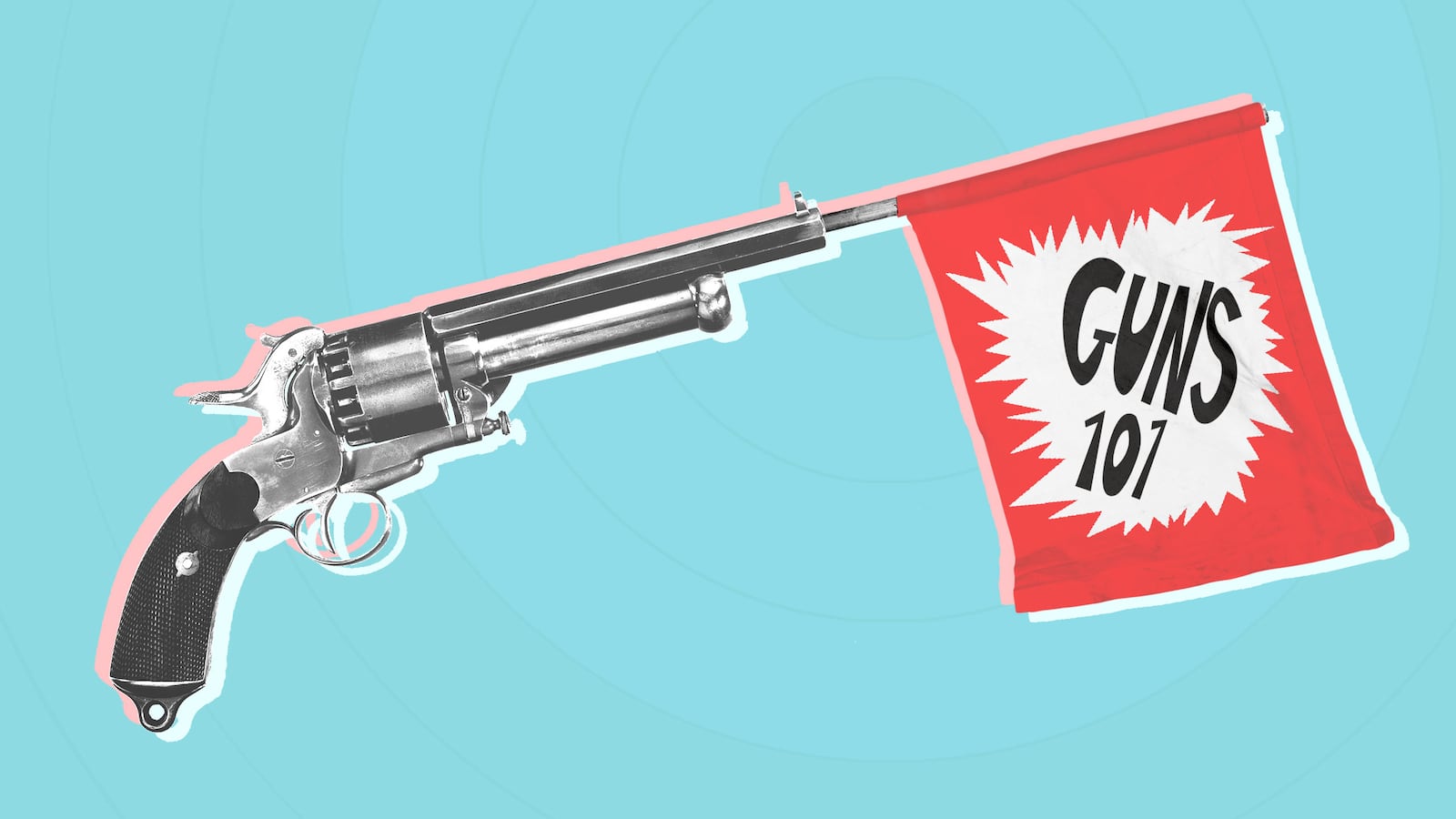1. What’s a semiautomatic weapon?
A semiautomatic weapon fires one shot every time the trigger is pulled until the magazine is empty.
AR-15s are “gas operated” -- the original design used “direct impingement” or “direct gas impingement” - a vent in the barrel funnels gas from the shot fired back through a tube, which pushes the bolt carrier group to the rear of the weapon, where it impacts the buffer, and is then sent forward, reloading another round.
AK-47s are gas operated as well, but use a long- stroke piston. The long- stroke piston is the reason for AK-47’s reliability, but poor accuracy. Some new ARs use a short- stroke piston. Short- stroke pistons are cleaner, but slightly heavier.
Pistols use a different mechanism to achieve semi-automatic fire. They are usually either recoil, operated for higher- power calibers, or blowback, operated for less powerful calibers.
2. What’s an automatic weapon?
An automatic weapon fires continually until the trigger is released.
3. Automatic weapons are in fact illegal, is that right?
Some are. There are specific restrictions, but lots of wiggle room. In order to own an automatic weapon in the US, you must have a Federal Firearms License (FFL).
4. So what is it about the AR-15 that these people love?
The ArmaLite AR-15 was designed to be a lightweight assault rifle and to fire a new high-velocity, lightweight, small-caliber cartridge to allow the infantrymen to carry more ammunition. It was developed to keep up with the Soviet AK-47, used by the North Vietnamese forces in jungle fighting in Vietnam. The rifle, when first produced, was not available for civilian use. It was designed and purpose-built to kill as many people as possible as quickly and efficiently as possible. The U.S. military purchased it in 1962 and designated it the M-16. It became standard issue for troops serving in Vietnam.
Initially, it was sold to law enforcement and a few civilians who saw themselves as “survivalists.” It became popular with civilian shooters after the 1989 Stockton mass murder (the perpetrator killed five children at an elementary school). Manufacturers of the AR-15 used aggressive marketing tactics to sell the weapon to the public and sales soared.
Many people like the AR-15 because it is very accurate, has very little recoil, and shoots high-velocity .223 bullets that hit with three times the energy of a 9mm pistol round and cause massive trauma to flesh.
5. What are some other guns like the AR-15?
The AK-47, SKS, Ruger Mini-14…basically any semi-automatic rifle with high-capacity, detachable magazines.
6. Were these banned under the assault weapons ban?
Some. See Public Safety and Recreational Firearms Use Protection Act, H.R.3355, 103rd Congress (1993–1994), Government Printing Office. Retrieved January 26, 2013.
The criteria for what constituted an assault weapon under the ban was sSemi-automatic rifles able to accept detachable magazines, with two or more of the following characteristics:
- Folding or telescoping stock
- Pistol grip
- Bayonet mount
- Flash suppressor, or threaded barrel designed to accommodate one
- Grenade launcher
Also, semi-automatic pistols with detachable magazines and two or more of the following:
- Magazine that attaches outside the pistol grip
- Threaded barrel to attach barrel extender, flash suppressor, handgrip, or suppressor
- Barrel shroud safety feature that prevents burns to the operator
- Unloaded weight of 50 oz (1.4 kg) or more
- A semi-automatic version of a fully automatic firearm.
Semi-automatic shotguns with two or more of the following:
- Folding or telescoping stock
- Pistol grip
- Detachable magazine.
The ban defined these semi-automatic firearms, as well as any copies or duplicates of them in any caliber, as assault weapons. Some weapons were created to specifically bypass the restrictions of the ban.
7. So these weapons were invented solely to be used by soldiers to kill other soldiers. Is that basically true?
Yes. These weapons were specifically engineered for the hunting of enemy soldiers on the battlefield and purpose-built to kill as many people as possible as quickly as possible. Any gunfight involves three elements: speed, power, and accuracy. The AR-15 has very low recoil, which maximizes target re-acquisition after firing a shot. It has detachable high-capacity magazines that enable faster reloading, thus getting the weapon back into action faster for a longer period of time between reloads. And as noted above, it fires a high-velocity .223 bullet that hits with three times the force of a 9mm pistol bullet. The bullet is designed to tumble and spin through the human body causing grievous wounds accompanied by a cavitation effect that damages or destroys tissue surrounding the bullet’s path.
8. And how can a person convert a semiautomatic to an automatic? Is it really easy?
There are kits that change the trigger assembly. There are also accessories like bump stocks, crank triggers, etc. Once you get one of these accessories, yes, it is very easy to convert the weapon. Obtaining the accessories is easy as well, as they are not subject to much regulation, and are generally very affordable (Slide Fire stocks range from $150-400).
9. And why would someone do that, and would it make a difference in these mass-shooting situations?
These modifications enable near-automatic rates of fire. Some shooters think that it is fun to blaze away at the range. That’s primarily how these accessories are marketed.
Mass shooters use these modifications to kill people more quickly. For instance, in Las Vegas, the killer was able to kill and injure as many people as the U.S. Marines and Army absorbed in two months of sustained urban combat in the Second Battle of Fallujah in Iraq in 2004. We are now seeing battlefield-level casualties on the streets of America.
While automatic shooting may be fun at the range, and it enabled the Las Vegas shooter to shoot rounds very quickly, professionals almost never use automatic fire when employing assault rifles, although military models do contain select fire options.
10. And what exactly do bump stocks do? And why was the Vegas shooter the first well-known mass shooter to use one—that is, why don’t all these people use them, if their goal is to kill quickly and indiscriminately?
They use the natural recoil of the rifle to depress the trigger faster and easier. According to the manufacturers, they are designed to “use natural recoil to ...fire multiple shots in succession… safely and accurately.” (Slide Fire). It’s marketed for range shooting most often. Their purpose is to simulate an automatic weapon’s rate of fire.
While the bump stock allowed the Las Vegas shooter to shoot a high number of rounds in a short period of time, it is important to note that bump stocks render a weapon hideously inaccurate – even more inaccurate than modifications to the trigger assembly that allow for automatic fire, because bump stocks utilize the “bump” of the recoil to achieve automatic fire. Professionals almost never use automatic fire with assault rifles. A military unit that require automatic fire uses much heavier machine guns, with longer barrels, shot from a prone position, typically with the use of a bipod or tripod.
11. Now let’s talk about ammunition. First of all, a “round” is one bullet, right?
A round is a single piece of ammunition comprised of a bullet (projectile), casing (usually brass), gunpowder (in the casing), and a primer (that is struck by a firing pin and ignites the powder).
12.And what’s a cartridge?
A cartridge is a round.
13. Okay. What’s a magazine?
A magazine is essentially a metal or plastic box that mates with a weapon that is used to store rounds for firing. It is most often spring-loaded to move rounds into the chamber during firing.
14. How many rounds does it hold?
It varies. Drums that coil rounds in a belt-fed fashion can hold 100-plus. Standard issue military magazines hold 30. Handguns are almost always based on size of the rounds and size of the grip (how much can the manufacturer fit in the space available). Larger magazines are sold aftermarket that will extend the grip to hold sometimes three times the ammo of the stock. California regulates magazines to hold 10 rounds max.
15. What’s involved in changing a magazine? How long does it take? And is it hot to the touch?
Press the magazine release, allow the empty magazine to fall or retain it in the non-firing hand, and replace it with a filled magazine. Experiences shooters can do this in mere seconds. The empty magazine is not hot to the touch.
16. We read that these people fired off 700, 800 rounds sometimes. Out of context, that sounds mind-boggling. Is it?
The cyclic rate for an M-16A2 or A4 or AR-15 is 800 rounds per minute. The restriction with an assault rifle is not how fast you can fire—it is how many rounds/magazines you can carry. The standard load out for a Marine would be six magazines, normally only loaded with 25 or 28 rounds, to protect the spring, for a total of 150-168 rounds.
17. When a recreational shooter takes a semiautomatic rifle to a shooting range, how many rounds will he fire off in half an hour?
It depends on the rate of fire. See here for M-16A2 and A4 rates of fire. As a Marine Corps Combat Marksmanship Coach, I know that a rifle qualification consists of four days. The qualification involves 50 rounds. Training days, shooters will shoot 70 rounds over the course of a couple of hours. During close-quarters combat marksmanship training, a “string” or “course of fire” might consist of 100-150 rounds, fired in drills of two-to-eight rounds. A course of fire might take 15 minutes to a half hour.
18. Now talk about hunting rifles. What are some popular rifles a person would take into the woods to kill a deer?
First off, you wouldn’t use an AR-15 for deer. The .223 bullet tumbles too much and destroys too much meat. Also, it isn’t large enough to ensure a single-shot kill - which is the object of all ethical hunters. Almost all deer rifles are bolt-action rifles that fire one shot at a time. Examples would be: the Remington 783, the Mossberg Patriot, the Weatherby Mark V.
19. Are these all single-bolt action rifles?
Yes.
20. And that means one shot at a time, basically?
Yes.
21. Do some people actually use semiautomatic weapons to hunt game?
Yes. Some folks use AR-15s to hunt nuisance animals, predators, or varmint such as hogs, or coyotes – when there is less concern with a quick kill, or preserving meat, or, in the case of invasive hog species, when a property owner may be trying to kill a large number of hogs at once.
22. And how about a really quick primer on bullet calibers?
Most deer rifles are chambered for .30 caliber rounds and larger, although there are smaller rounds, such as the Winchester .270. The range usually tops out around a .308 Winchester round. Of course, every deer hunter has his or her favorite rounds and they will argue endlessly about which is best.
In the tactical community, arguments over caliber are a constant debate. Shooters will talk about “stopping power,” kinetic energy transfer, terminal ballistics, bullet drop, penetrability, max effective range. What is important about the 5.56mm round of the AR-15 is the “small caliber high velocity” concept—a round that can penetrate, but is small enough that it does cause very much recoil, allowing the accurate placement of rapid follow on shots.
23. Okay, let’s move to handguns. These, too, come in single-shot, semiautomatic, and automatic varieties?
While there are some single-shot pistols, handguns mostly come in two types: revolvers and semi-automatics. Revolvers come in single-action and double-action. Single action is when you have to cock the hammer with your thumb before you can pull the trigger. Double action is when the trigger pull cocks the hammer and releases it to strike the bullet primer.
24. And are automatic ones banned?
There are automatic pistols, but they are very rare due to their inaccuracy. They require a FFL license.
25. No one hunts with a handgun, do they?
Yes. Many people hunt with handguns. Typically these are revolvers, and many people use scopes on them as well. The bigger the animal, the bigger the handgun used. The really big ones, like the .454 Causll and the Ruger .480 are not fun to shoot due to the extreme recoil. The Smith and Wesson .500 pistol round is truly awful to shoot.
Some hunters will carry pistols as self-defense weapons as well.
26. What are the legitimate reasons someone would own one?
As stated above, some hunters do use a handgun. It may seem odd, but like bow hunting, handgun hunting offers its own unique challenges that appeal to some hunters. Hunters may also carry a pistol as a personal defense weapon – against possibly aggressive animals, such as bear, or moose. Finally, while the merits of owning a gun for self-defense in populated areas may be debated by both sides, it is certainly difficult to begrudge folks who live in very remote areas, such as Alaska, who may own pistols for personal protection and self-defense.
27. We all know that it takes all kinds of people to make the world go round, but: Can you explain the thrill or joy of shooting a gun?
Target shooting can be fun. Like at a golf driving range, or batting cage, it’s a challenge to shoot accurately. It’s more challenging to shoot accurately and quickly. And it’s supremely challenging to shoot accurately and quickly while moving. There is also a social aspect to a shooting range or gun club. Many of the people there are normal, well-adjusted humans. In many ways it is the same as any skill-sport. There’s the challenge of doing it well, and joy when it happens.
As for myself, while I shot occasionally growing up, we did not own guns in my household. I shot as part of Boy Scouts, or the rifle team briefly in my high school. But I fell in love with tactics and marksmanship when I joined the Marine Corps. There is a terrible beauty to a squad of infantry Marines moving in coordinated precision through a field, or through a house, clearing rooms.
Marksmanship, like martial arts, is a physical endeavor. A gun has weight to it. The noise of a burst raises the adrenaline. Your senses can heighten, and your muscles tighten to absorb the shock of recoil when in an aggressive shooting stance. I’ve run gun drills with no ammunition until my hands bled, and shot until I was sore from recoil and holding the weapon, my flak jacket soaked through with sweat. There is a satisfaction in that kind of weariness, like after a gym session or a run.
Marksmanship requires practice, discipline, patience, skill. It is a rewarding and challenging endeavor, even more so when practiced as part of a team or squad.
28. What are some dumb, uninformed things you’ve heard gun-control advocates say in gun debates?
Nothing rankles a gun owner more than someone unfamiliar with guns making claims about weapons that are untrue, or misidentifying parts of a weapon. It is a magazine – not a clip. An assault rifle is not a “machine gun” – a machine gun is a much heavier weapon, meant to be implemented by a crew of 2-3, designed for automatic fire.
On the flip side, I’m often horrified by the weapons-handling of civilian gun owners – I’ve been “flagged” (when the line of the muzzle crosses my body) countless times by folks claiming to be safe and responsible gun owners. “But it’s not loaded” they might insist. In the military we treat every weapon as it if were loaded. Also, keep your damn finger straight and off the trigger until you intend to fire.
Not all gun owners are gun-hugging, Bible-thumping nut jobs.
Not all gun reform advocates want to seize all your weapons.
My personal pet peeve is Hollywood myth – guns don’t go “click” when they are empty. The bolt of the rifle, or the slide of the pistol, will lock to the rear.
This may seem like a small gripe, but assault rifles, pistols, shotguns – these are tools in the hands of military and law enforcement professionals. We treat them without passion or prejudice. As stated in the Marine Corps rifleman’s creed: “We seek to master [them], as we master [ourselves.]” We try to employ them to achieve the desired effect on target, as safely, efficiently, and professionally as possible. This means dedication to training with, handling, and firing these weapons. In order to talk about guns, we have to sweep aside myths, allusions, passion, and look at them for what they are. Misunderstandings on both sides have to be corrected – even something as simple as a “click.”
Peter Lucier is a Marine veteran and a student at Montana State University.






